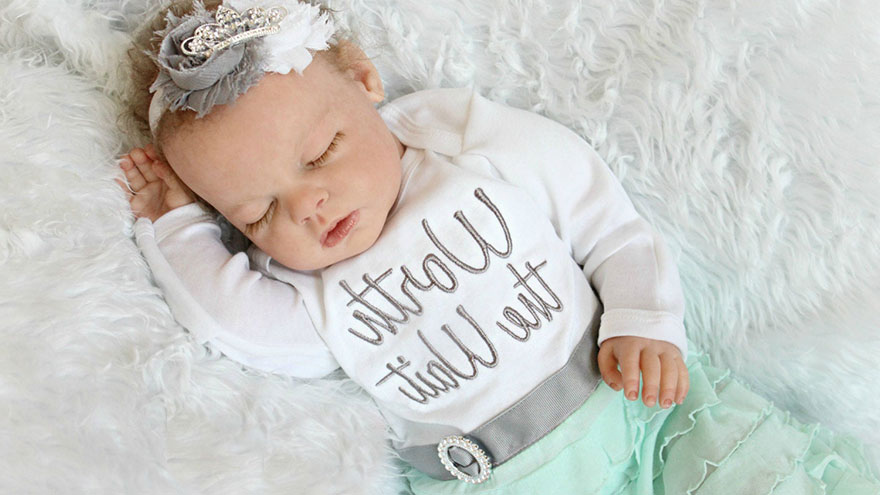Basic Clothing Needs of a Newborn
Tiny dresses and hats. Itsy bitsy socks. Almost nothing is cuter than newborn clothing — other than your newborn, that is. But don’t rush to buy out the clothing store.
Newborns grow quickly, and what fit yesterday may be too small tomorrow.
Instead, stock up on the basic clothing essentials, saving your money for when that newborn is a teenager — and eating you out of house and home.

Underwear and Diapers
Undershirts are a must for keeping your newborn warm. Skip the onesies at first, as they don’t allow air to dry the umbilical cord. Undershirts, on the other hand, will keep your newborn’s torso covered while allowing the umbilical cord to heal.
Once it falls off, you can switch to onesies, which are one-piece T-shirts that fasten over the diaper. This prevents the T-shirt from riding up under your newborn’s clothing. Undershirts and onesies come in long and short-sleeved versions, so choose according to the season.
You’ll need between four and six undershirts and three to four onesies for the first month of your baby’s life — as long as you have a washer and dryer close by. Whether or not you consider diapers as clothing, they are still a basic need of newborns. Although 95 percent of parents still use convenient disposables, according to 2013 information from WebMD, some choose fabric diapers, which are now more colorful than your grandmother’s cloth diapers.
Whichever you choose, be sure to get a lot: Today’s Parent recommends having between four and five dozen diapers ready for your newborn.
Basic Clothing Items
Dress your new baby in soft, comfortable outfits. Plan on having about five pairs of pull-on pants and an equal number of matching shirts, eight pairs of soft booties or socks — shoes are not needed or recommended — and two pairs of soft mittens designed to keep your newborn from scratching himself.
Choose long-sleeved, thicker clothing for newborns born in the fall and winter, and thinner, short-sleeved clothing — such as leggings or shorts instead of pants — for babies born in warmer weather.
In addition, you might want to have some dressier outfits ready for special occasions, such as meeting the grandparents for the first time, attending church, or going to a party.
Sleepwear
Sleepers and pajamas are a must for newborns — and they come in different styles. Nightgowns — sometimes called infant gowns — zip up the front, have short or long sleeves and are loose around the legs.
They close at the base, but you can open them easily for diaper changes. One-piece sleepers have sleeves and leggings all in one piece, and include attached booties to cover the feet. They zip or snap up the front. Plan on having three to four gowns and between three and to six sleepers on hand for your newborn, suggests WebMD. And if your newborn was born in the winter, you may want to invest in one or two blanket sleepers, which are similar to nightgowns but much thicker.
There are also sleeping sacks available; these are wearable blankets or sleeping bags that replace actual blankets, which can potentially trap a newborn. You should also have seven or eight receiving blankets on hand, as you can use for swaddling or as burp cloths. You’ll also need about three large cotton blankets to keep baby warm in the stroller, car seat or any place where he might catch a chill.
Hats and Outerwear
Most body heat escapes from the head — and this is especially true for newborns. Keep your little one warm and cozy by slipping a soft cap over his head. You’ll likely want to have two caps. Outdoors excursions require special clothing as well. In sunny weather, protect your newborn’s sensitive skin with a wide-brimmed bonnet or any other cloth hat that has an attached brim.
One or two light sweaters or jackets are probably enough to keep your baby warm outdoors if the weather is nice. If the weather outside is frightful, choose a thick, warm hat that covers the ears. Cold weather also means you will need to bundle up your newborn in something warm.
Snowsuits have soft, insulated layers with water-resistant outer fabric. Another option is a fleece suit, which is thick and soft but not water-resistant. Some have built-in legs, while others are shaped like sacks with sleeves. Both come with or without attached hoods, depending on your preference.
One is usually enough.
You Might Also Like :: What Are the Most Expensive Purchases for a Newborn?
Check out the video version of this article on YouTube

